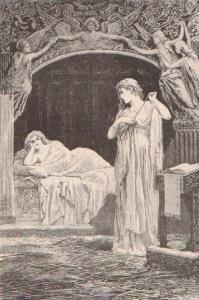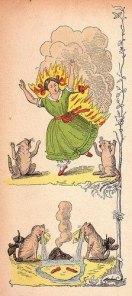Strange is the night where black stars rise,
And strange moons circle through the skies. – Robert W. Chambers
Tomorrow is May Day, and today May Eve; though the tradition has waned in the past century, it was once viewed in the same way as Halloween: a night for ghosts, haunts and dark doings. In my first column for the occasion I shared my list of the ten scariest short stories, and in last year’s column the scariest TV show episodes I’ve ever seen. This year, I present thirteen main selections (five movies, two poems, one television miniseries, four short stories and a fairy tale) plus a few lagniappe items, ranging from the fun to the beautiful to the horrifying; most can be described by two or even all three of those adjectives, and I doubt many of you will be familiar with all of them. I’ve provided PDF copies of all the tales and poems, and links to view or buy the shows.
The Call of Cthulhu (2005) A group of ambitious Lovecraft fans asked themselves, “What if his most famous story had been adapted for the screen shortly after it was published in 1928?” The result may be the best of all Lovecraft film treatments, especially if you can appreciate silent film.
 “Christabel” (1816) is Samuel Taylor Coleridge’s sadly-unfinished poem of a lesbian vampire. Though it has other complexities of theme, it is this overt meaning which has had the strongest resonance; J. Sheridan Le Fanu’s “Carmilla” (1872) is basically a prose adaptation of it, and the lesbian vampire motif has appeared in many movies from Dracula’s Daughter (1936) to the present.
“Christabel” (1816) is Samuel Taylor Coleridge’s sadly-unfinished poem of a lesbian vampire. Though it has other complexities of theme, it is this overt meaning which has had the strongest resonance; J. Sheridan Le Fanu’s “Carmilla” (1872) is basically a prose adaptation of it, and the lesbian vampire motif has appeared in many movies from Dracula’s Daughter (1936) to the present.
The Kingdom (1994) Lars von Trier wrote and directed this bizarre Danish miniseries of ghostly, psychic and otherwise-weird goings-on at a super-modern hospital built on what was once a haunted bog. Steven King adapted it for American television a decade later, with predictably piss-poor results; the  original is much, much better.
original is much, much better.
Kwaidan (1964) is Masaki Kobayashi’s gorgeous film version of four Japanese ghost stories translated by Lafcadio Hearn. The word “unforgettable” is badly overused in movie advertising copy, but this is one time it’s richly deserved.
“Man-size in Marble” (1893) by Edith Nesbit used to be very common in horror anthologies; it was one of the first horror tales I can remember reading, certainly before the age of ten. But since it isn’t as commonly collected as it used to be, some of my readers may be unfamiliar with this chilling little example of the traditional English ghost story.
The Monster Club (1981) is one of the strangest and most uneven films ever made. Vampire Vincent Price brings horror writer John Carradine to a London nightclub whose members are all humanoid monsters, and there tells him three stories: one sad, one absurd and one horrifying. There’s also music and a stripper. Don’t take this one too seriously; just enjoy the weirdness.
The Mystery of the Wax Museum (1933) Though Vincent Price’s performance as the mad sculptor in House of Wax (1953) was superior to Lionel Atwill’s in this original version of the story, this two-strip Technicolor gem is better than the remake in almost every other way. I especially love Fay Wray as Lois Lane prototype Charlotte Duncan, the ambitious and hardheaded “girl reporter” whose curiosity leads her to the brink of a gruesome fate.
Psychomania (1973) is another oddball British horror movie in which a sorcerer’s son turned motorcycle gang leader discovers how he and his followers can become undead, and after they do they embark on a reign of terror only his mother can stop.
“The Tongue-Cut Sparrow” was my favorite fairy tale as a wee lass; I must’ve asked Maman to read it to me hundreds of times. You may wonder why a fairy tale is on a horror list, until I tell you it’s a Japanese fairy tale; if you still don’t get it, read the story. Yes, I was a strange child.
“The Vampyre” (1819) is the only other surviving product of the famous “ghost story” contest between the Shelleys and Lord Byron that rainy summer on Lake Geneva. Though Frankenstein eclipses it in every way, Dr. John Polidori’s entry (based on a plot by Byron) is the first known vampire short story in English, and influenced all which came after it.
 “The Very Sad Tale of the Matches” (1845) Germany is probably the only country whose children’s literature is more horrific than that of Japan; I’m sure most of you are aware of what the original un-Disneyfied Grimm’s fairy tales are like. Heinrich Hoffmann was a psychiatrist who wrote a cheery little book (originally for his son) named Der Struwwelpeter, in which minor childhood misbehaviors (such as nose-picking) precipitate horrific punishments (like having the offending fingers cut off by a man with gigantic shears). This selection from the book has, in my opinion, the most striking disconnect between the tone and language and the awful goings-on therein.
“The Very Sad Tale of the Matches” (1845) Germany is probably the only country whose children’s literature is more horrific than that of Japan; I’m sure most of you are aware of what the original un-Disneyfied Grimm’s fairy tales are like. Heinrich Hoffmann was a psychiatrist who wrote a cheery little book (originally for his son) named Der Struwwelpeter, in which minor childhood misbehaviors (such as nose-picking) precipitate horrific punishments (like having the offending fingers cut off by a man with gigantic shears). This selection from the book has, in my opinion, the most striking disconnect between the tone and language and the awful goings-on therein.
“What Was It?” (1859) Fitz-James O’Brien wrote only a small number of tales before his untimely death in the American Civil War, but they reveal a talent which might have made him one of the greats had he lived to develop it. This is the very first example of a story in which there is a creature who is invisible, yet tangible; it is not a ghost but a living being, and its invisibility is ascribed to an undiscovered scientific principle rather than a supernatural one. If anything, the tale is even creepier because of that.
“The Yellow Sign” (1895) If you have watched the television series True Detective, you’ve heard references to the Yellow King and the city of Carcosa; both are borrowed from this story and others by Robert W. Chambers, which revolve around a mysterious play called The King in Yellow which brings madness to all who read it (or even own a copy). Chambers’ work is of very uneven quality, but this one and “The Repairer of Reputations” (also included in this PDF) are outstanding.
